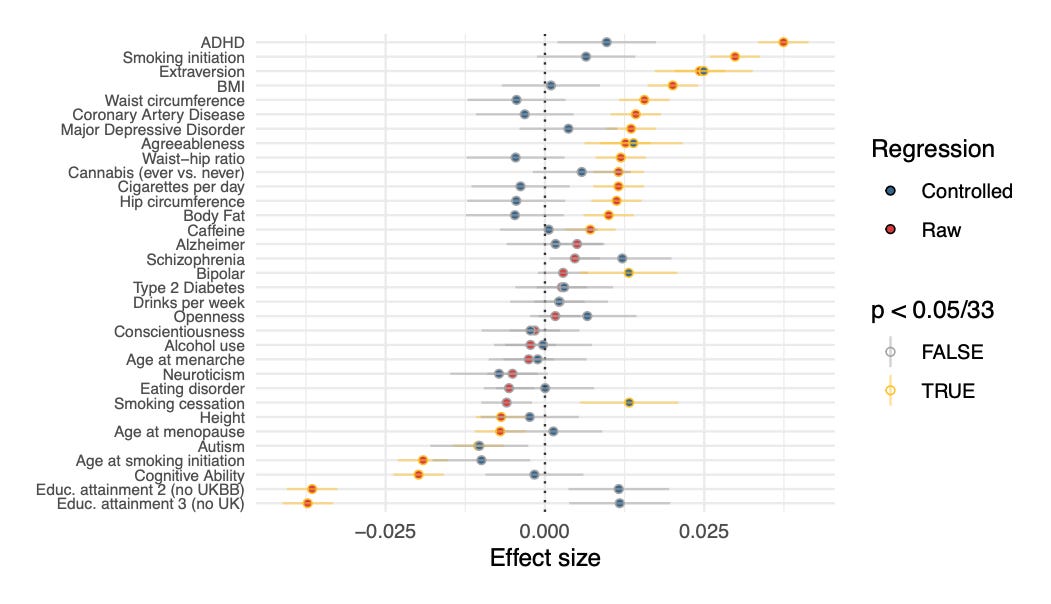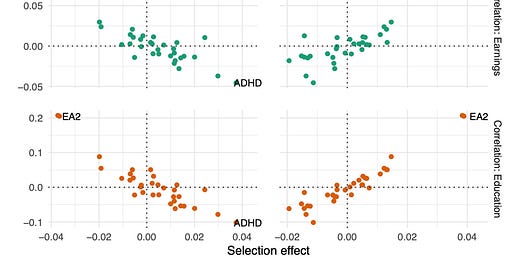The natural selection paper, part 2: theory
What explains natural selection in contemporary humans?
This is the second of three posts talking about my new paper with Abdel Abdellaoui on natural selection in modern humans. The first post described what we saw in our data:
There is natural selection on several polygenic scores: that is, these scores correlate with fertility.
Correlations with fertility are larger among people with lower incomes and less education, and among people who are not living with a current partner.
Correlations with fertility are reversed among older mothers, and reversed if we control for a person’s age at the birth of their first child.
These are striking and puzzling patterns. To explain them, we use the economic theory of fertility, originally developed in the 1960s and 1970s by Gary Becker. Becker was trying to explain why rich people have fewer children than poor people. His innovation was to bring in an idea from consumer economics: he treated children as just another consumer good which someone might purchase. Of course, people don’t generally buy their children from a store, but they do invest time and money in childcare, education and so forth, so the logic is not that different. But rich people buy more of most goods than poor people, so why do they “buy” fewer children?
For us, Becker’s most important insight is that children cost time as well as money. Because of this, a raise in a person’s earnings will have two effects. It will make them more able to afford a child (an “income effect”). But it will also make it more costly to take time off work for a child’s sake, since by doing so, they will forgo a higher hourly wage (a “substitution effect”). These effects push in opposite directions. The income effect means higher earners will have more children. The substitution effect means they will have less.
This story of opposing effects rang a bell with us. We had opposing correlations with fertility too, for our polygenic scores. Could income and substitution effects be the underlying reason? And could the balance of these forces go in different ways for different people?
For example, if you are a single parent, having an extra child may be quite costly in terms of time. That makes the substitution effect bite hard: you will forgo many hours of extra wages for one child. Couples may find it easier to work out childcare between them, making the substitution effect weaker. (Becker pointed out that couples might choose to have one person specialize in childcare, leading to the traditional one-earner family, even if initial differences in earnings power were small.) So, higher earnings would have a more negative effect on fertility among single parents. Among couples, the substitution and income effects might be evenly balanced.
For our story to be true, the mechanism must be earnings. If a polygenic score leads to higher earnings, then it will also affect fertility, via those earnings’ income and substitution effects. In this paper, we don’t provide a knockdown proof that this is what is happening. But we have some suggestive evidence. We use two measures which relate to earnings. One is household income. The other is education, which is a good predictor of lifetime earnings.
In the figure below, each dot is one of our 33 polygenic scores. The x axis shows the score’s correlation with fertility, i.e., the strength of natural selection on the score. The y axis shows the score’s correlation with earnings (in the top row), or with education (in the bottom row).
On the left hand side, you see the raw correlation with fertility. There’s a clear pattern. Scores which are positively correlated with earnings and education are negatively correlated with fertility, and vice versa. For example, EA2, a polygenic score for educational attainment, positively predicts earnings, and negatively predicts fertility. This could be the substitution effect in action. People with high EA2 are more likely to get high paying jobs, and this makes them less willing to have children. So, the left hand graphs provide some evidence that modern natural selection is driven by earnings in the labour market.
On the right, we plot the correlation with fertility after controlling for age at first live birth. That is, among people who have their first child at the same age, which scores predict having more or less children? As my last post described, the effects are reversed. For example, EA2 predicts having more children controlling for age at first live birth. And as a result, the overall pattern is reversed: scores which predict higher earnings predict more children with this control.
Here is one story that could explain these reversed effects. Suppose people have an idea of how much they are likely to earn in the labour market, and whether it’s worthwhile staying in education. People with polygenic scores that predict low earnings will not find it worthwhile to go into further education. They will enter the labour market early with relatively low wages, and will have their first child earlier on average. People with high-earning polygenic scores tend to stay in education longer. So they have children later, and fewer children overall. But, once they are in the labour market, those who earn more are able to have more children – the income effect at work.
We also test our theory in another way. We re-estimate our scores’ correlations with fertility, controlling for earnings and education. If scores are mostly affecting fertility via the channels of earnings and education, then after we’ve controlled for these, the correlations should disappear. That is just what we see. The graph below again shows effects on fertility for each of our polygenic scores. The red dots are the raw effects: as before, these measure the strength of natural selection. The blue dots are effects once earnings and education are controlled for. They are much smaller, and almost all are not statistically significant. So, again, one interpretation for this graph is that most natural selection on polygenic scores takes place via the scores’ effects on earnings and education.

We think these graphs provide reasonable evidence that labour market income and substitution effects explain the pattern of results we see. In the paper, we also talk about how they can explain stronger natural selection among lower-income and less educated people.
A really solid proof of our theory would be evidence that some polygenic scores truly affect fertility via higher education and earnings. This is a causal mediation analysis, and those are quite hard to do right…. Watch this space.
My next post will step back and ask the most important — and controversial — question of all: so what? Natural selection is working against polygenic scores for (e.g.) educational attainment, and for scores for (e.g.) ADHD and coronary artery disease. Is that a big deal? How should we think about it? And what, if anything, should we do about it?
If you liked this content, then I would love you to do three things:
Subscribe to this newsletter. It’s free, posts are occasional, and subscribers make me happy.
Share this post on social media. This newsletter is a new venture for me, so by telling your friends and/or followers, you’ll be doing me a huge favour.
Read about the book I’m writing. It’s called Wyclif’s Dust, too. You can download a sample chapter.



